This A to Z is based on cycling as a woman alone in India, which makes a whole lot of differences. Before I cycled through India, I have travelled extensively by public transport and always solo. I haven’t counted the exact entries into India but it must have been more than 15 times.
Only a few short occasions I was accompanied by a Western man, which I found hard as incoming thoughts and imprints are influenced by the other his concerns, but the attention is divided and as a guided woman you automatically generate another perspective from locals; traveling with a non NRI (Non Residence Indian) changes everything however.
This A to Z is based on cycling in the low lands and plains of India, the Himalaya is very different (easy and quiet on the senses). I cycled from South to North, about 3600 kilometer. I have been to every state, except the far North East, known as the Seven Sisters States.
These are my thoughts and beliefs, don’t confuse that for the absolute truth for every lone female on a bicycle. This post has become rather discriminating at times, but remember that I haven’t praised the good people, the vast majority, in and outside India.
A for Animals
India is known for it’s holy cows but don’t dismiss the monkeys. There are generally speaking two species: the Gray langur with the long elegant tail, blond hair surrounding a friendly black face and the brown ones with a reddish face and butt, the Rhesus macaque. I dislike those, and so do most others. Be aware that they search your stuff in for food. The cows however can be nasty too. I have been attacked a couple of times, and a horn stabbed in your crotch isn’t fun. Dogs are generally speaking fine, they won’t chase you nor attack you when on the bicycle as they are mostly in a lethargic state. I have been bitten once, and that was years ago in Dharamsala when I was walking with a bag of food for the dogs. The harder part is to keep your mood up when seeing some of the dogs; some live with broken legs, hairless scabies skin, bloody bulges and wounds.

Try to cycle in a loop around a big bull. Keep your food away when passing red-faced monkeys and in case of a close encounter, act submissive. When going out to pee in a grassy or grown area, knock on the ground to avoid snakes. By the way, rats may occur in your room so be sure to leave food out of your panniers or they might bite through it.
B for Beliefs
I do not want to discriminate but by raising this subject I already do. Yet, try to read it through the eyes of a sign above a laundry shop I saw in Amritsar ‘The only place with real discrimination’.
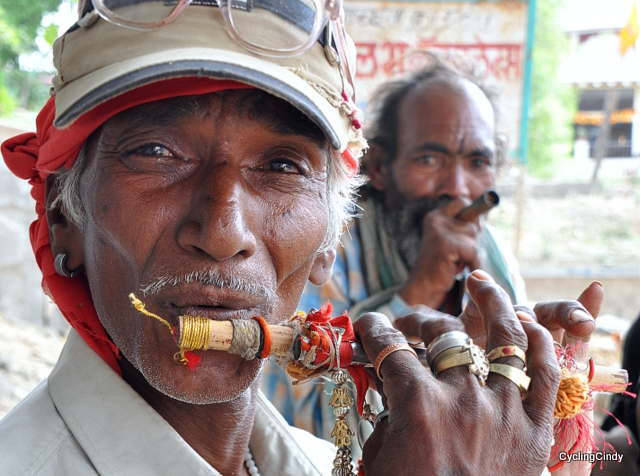
A most interesting man. He was bought food, chai and approached submissive by passerby’s. He chewed razor blades too, and like Krishna, played the flute.
I like India so much because it is India; a Hindu country. Set aside the population their beliefs, I think they’re funny people with a typical kind of behavior which often makes me smile. A particular kind of behavior you won’t see anywhere else. Though, they often get me annoyed too. In India the term ‘belief’ start to play a role right upon entering. Without pointing directly to a follower of a certain faith or belief, who might not be recognizable after all, I came across this finding: in general I find Muslims, Sikhs and sadhu’s most comfortable to be with, exceptions aside. India is a country inhabited mostly by Hindus, Muslims, Buddhists, Jains, Christians, Zoroastrians, Judaists, Baha’i Faith’s and many movements and philosophies and subdivisions. I find that Muslims in general tend to care well for strangers but in India they leave you in peace; no starring, no intruding, no questions. The Sikhs generally are dauntless by your appearance, which I find comfortable. Sikh’s don’t find you top of the world and won’t stare at you in disbelief, they might stop along the road and invite you over in one of their temples though. Sadhu’s are spiritual seekers, having turned their backs on mundane life and seeking spiritual wisdom through a lifestyle without attachments nor belongings. I find they are the coolest people of all, for them, you seem nothing special and/or equal.
B for Bars
Although I don’t drink alcohol, I was happy to stay the night in a bar. A bar doubles as a hotel, maybe to avoid drunkards to drive back home, or maybe to have a cozy men night out? A small part of the ground floor is your typical bar style with tables and seats, a man behind iron bars who sells all kind of liquor and beer. And… is able to materialize fried fish! This was one of my very few chances to order fried fish. Equally notable was the treatment I got in those bars; I was protected by the men in charge. I was treated like a princess: and I was absolutely not to be disturbed, not having to come over to the smoky drink den but instead everything had to be brought to my room, sometimes they would even carry my panniers.
B for Boys


I can’t keep from mentioning the brown underwear, the real biceps, the hand that shoves the sleeve and the girl her expression. This photo says it all!

What a beautiful Bollywood-alike young (17) truck driver!
Boys, and I mean young men, tend to be macho (the three boys above were not macho!). Dressed funny in Western ‘fashion’ and becoming a macho caricature. They often try to act like Bollywood actors, who, in their turn, are acting out a role (which they often believe true). Anyway, boys/young men think they know better and are better (this is partly due to upbringing) and they think a girl, even a women above 40, is inferior. They tend to think we are weak, not very smart, silly, a bit stupid and clumsy. This might seem true but only because girls or young women suffer from lack of self-assurance. Those boys can be a huge annoyance but rather funny would you be in the mood to laugh at. Just try to take advantage of those know-it-all’s and finish their arrogance with a sharp reply full of facts. Walk away after you’ve made clear to stop fussing about you. ‘Thank you, I am fine, don’t disturb me anymore’. Make a halt to their machismo. Be firm and clear, because their mom and sisters don’t!
C for Cheating
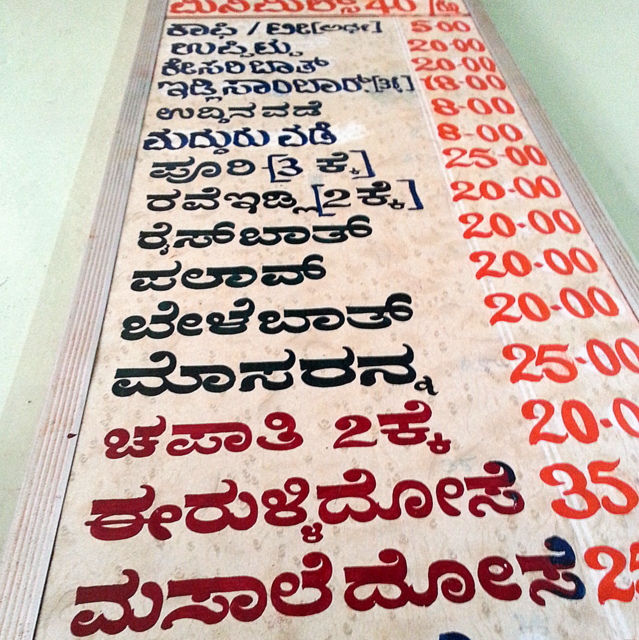
India is known for cheating and that is certainly true in touristy area’s. You are a fool if you do not know the prices; thus some take advantage of that. Outside touristy area’s people are honest and won’t cheat you. If they do, you recognize it quickly by the few seconds of hesitance before they give you the price. When you know fares there is no need to ask anymore as there is a fairly even set price for food and groceries. In case they overcharged me I would not make a fuss but leave the general fare. Almost all places where you eat have a menu card with prices, except the truck dhaba’s.
On every machine packed article is a MRP printed (Maximum Retail Price).
Holy people and sadhu’s usually don’t ask you for money, or donations. A sadhu is happy with whatever you give, so all who try to get your pockets emptied (fake priests, fake hand readers, professional beggars and all kind of help overly enthusiastic offered) are cheating you.
C for Culture Shock
India can be hard on your senses. Although I guess when you reach India by bicycle, you’ve already seen a lot: Pakistan is India’s forebode but all other countries with an open border to India are not really preparing you for the full India experience. India can be very hard on your senses. I have seen people dying on the street, out of poverty. People exhaled their last breath along the highway, out of exhaustion. Witnessing general suffering changes your perspective on life. Poverty can be a very hard slap in your face. Ignorance from passerby’s might look too hard to be true. Inequality is extremely high. The misery of farmer’s sometimes shows, and as a cyclist you pass many farmers; knowing their life situation is not optimistic. The almost slave-like situation of worker’s is clear. Slums, low-caste beggars, untouchables, scavengers, hunger and homeless not washed for years can be daily occurrences; it can stir up emotions, feelings and questions of deep philosophical source. Try to remember that each individual has its own reaction and try not to blame well-off locals for their ignorance or seemingly hardness. Try to see through every situation, that of the poor and that of the rich. Try not to make a conclusion formed by pity or guilt. And above all, trying to stop understanding might help you too.
C for Camping

High altitude camp one day before reaching the Kunzum pass of 4550 meter in Spiti & Lahaul .
When I cycled through India it was immediate after a couple of rape- and killing cases of Western cycle tourers who were attacked at their stealthy camp spot. I was not alarmed since I had been to India so often and therefore I knew that stealth camping wasn’t even an option for me. I like camping to be a slow, cozy exposition. And I knew in India I would never be alone. I knew I would feel disturbed by locals walking off to poo, pee, tend their fields or just wander around. In India I had never been alone for long, not on one occasion, however far I strayed. So this time on the bicycle I was not even going to try. I start camping once in the Himalaya and although I was accompanied by a man for a few weeks, I would have done this on my own too. It is possible to camp in home yards or at truck dhaba’s but I knew I would not have much peace of mind nor privacy, so I didn’t bother and instead choose lodges.
D for Danger
I guess you rather know about danger than the D for ‘dress’ or ‘dualism’. Is India dangerous for a solo woman cyclist? No. India is just like any other country, there is no danger more than in your own country. But you must know where you are and how to adapt to the customs of this country, just like any other country. There is not more danger of harassment, rape, mugging, robbing, bombing or attacks than any other average country known to be safe. The traffic is what makes it risky. Be cautious, dress strikingly (not half-naked) so you are to be seen. I bought a helmet in India (after a terrible accident, but luckily not the victim). Do not as I did, assume that you as a cyclist are in your right. In Indian traffic you as a cyclist have no rights. A cycle bell has therefore no use, in my experience. Use your voice and raise it hard!
D for Dress

Flies are not caught with vinegar but with honey
Unfortunately, men can not always behave themselves; it’s stronger than them. So let one be the wisest if you don’t want to be confined.
This is a very personal topic but I strongly believe that when you go to any country, you should adjust. As far as personally acceptable: a woman in full hijab won’t go in hot pants when visiting California. So if you dress revealing in a country where most locals don’t, then in my opinion it is you who is most responsible for any indecent behavior from people around you. This however is tricky in parts which are very touristic. Some parts in India are overwhelmed by tourists who dress super revealing. And because other tourists do make you look similar through the eyes of locals, even though you are dressed decently. Some locals tend to believe television, thus Western women are truly open-minded, especially on the sexual front. On the other hand, India is still a society where woman rights are not as advanced as in the West, and therefore a woman on the bicycle is already a novelty on its own. Extra reason to dress appropriate and you will gain respect, and definitely be less harassed. Don’t try to be a new age hippie in broken and dirty rags, neither be a super sporty athlete in tight Lycra, unless you cover your shoulders, legs, breasts and bum with something wide. I wore a calf long legging with a long wide blouse with T-shirt underneath and a turban (against heat).
While the sari is a very elegant and a hyper feminine style of dressing, where the midriff is bare and the shape of breast is outlined clearly, do not make the assumption sexiness and naked skin is all right. Even though a salwar kameez or tunic is tight, finish it with a scarf draped over your breasts when not cycling. You are not an Indian woman and the way you dress gives off a different signal. I’m not saying you should dress in a potato sack but cover yourself up in light cotton wide clothes. I make sure that when I bend over my sport bra is not for everyone to look at. Whatever the tourists in Cochin, Delhi and Hampi are doing is not the overall dress code (it is in Europe on a hot day). By the way, covering up protects you against the sun.
D for Dualism

Road side dwellers who cut stones to small pieces, see their expressions!
There is no country on earth where dualism, duplexity and opposites seem to be bigger than here. For each terrible happening, unappealing sight, annoying person or heart breaking moment is an equal opposite. Every day, almost every hour, in every town, in every face, everywhere. India is exhausting for this alone. The more you see, the more deep it cuts. For me, India is my ‘favorite’ country because no other place on earth is so complex. There is not a more difficult country to move in, yet the deepest happiness may reach you too. Your sense of receptiveness may be widest here, as all familiarity is gone. There is no bigger challenge than cycling through India. Sure, there is no lack of food, water nor lodges, there are always people to get information and you will never be alone. Yet, you wish you were; see… dualism. Quietness can be found in Nature, which you will only reach thousands of kilometers further in the mighty Himalaya. Reflection you will find in an ashram, but you need to get there first, which will be another battle; the true self insight. Once you reach that place of silence or reflection there is not a greater reward because it was such a struggle. That daily fight to reach a certain balance might be most difficult in this country, but when you reach it, the satisfaction is the biggest you’ll ever find. Cycling in India is a real inner question. And remember: no one told you to go to India.
E for email and internet
Get yourself a SIM card in Delhi where they are for sale under the counter, or try to get it from a hotel owner in touristy places. Otherwise; forget it. There is hardly any open Wi-Fi and many people will not give you the password. They won’t even tell you the reason. But the reason is that bomb attacks on the president were done over Facebook. To get a SIM card anywhere else you need to have a registered address and income in India. Internet café’s are working but power often not and if power does work, connections are slow. You need to register in most cybercafé’s, take your passport with you.
F for Food

When you are not a vegetarian you probably won’t miss out on having no meat in India. Food is incredible tasty, tending to be spicy. As a cyclist you are mostly eating along the roadside, and that is exactly where the very best food is to be found. The truck dhaba’s restaurants became my favorite. There is never a tourist, which leaves the truckers in awe and usually they try not to look at you directly. The truckers are so mannered that they leave contact up to you. Of course, they watch you, but in such a way that it doesn’t disturb. The food is fresh and has an array of cultural favorites, depending where the dhaba-owner comes from. The usual fare is rice, lentils dhal, unleavened flatbread chapati, vegetables zubsi (eggplant, okra), yoghurt curd, and a basic salad (often not more than cucumber) and this might look boring, yet it became a highlight of the day: food!

At a truck stop dhaba of a Rajasthani. I recognized his origin by his ear lobe.
Remember that rice is endlessly replenished, this goes for a thali, plate with rice and many sorts of vegetables and curry too. You pay one price and keep getting vegetables, curries and rice.
Street food in its most simple form is something you have to stop for. It’s incredible to see how quick it is prepared, how it tastes and to find out how other people devour it. Food often consist of all the 6 taste’s (sweet, sour, astringent, pungent, bitter and salty) which leaves you perfectly content after each meal.
G for Geological

Zanskar, north India

Conoor, South India

Narayan Sarovar, East India
That’s the greatness of India; she has it all! Mountains, desert, wetlands, grasslands, forests, hills, and the ocean. Sun, haze, dust and rain will be most prevailing for a cyclist. Temperatures above 50 degrees (122 Fahrenheit) in the months of April, May, June and July on the plains, and cool in the mountains, to impassable in winter. There are National Parks, where you are not supposed to cycle through but park rangers tend to forget to tell you this. However, the huge elephant dung remind you not to have a pick-nick and if they do not ring a bell, the tigers might. And if they do not disturb you, the car drivers will tell you not to stop. India is immensely diverse and each state has remarkable differences. The South has a very different vibe than the North and all the way up North is being away from India as most of us think of India. States bordering another country are drenched with the neighbors’ way. Being in India makes you wonder: ‘What is India?’ The more you get there, the less you understand.
H for Holy
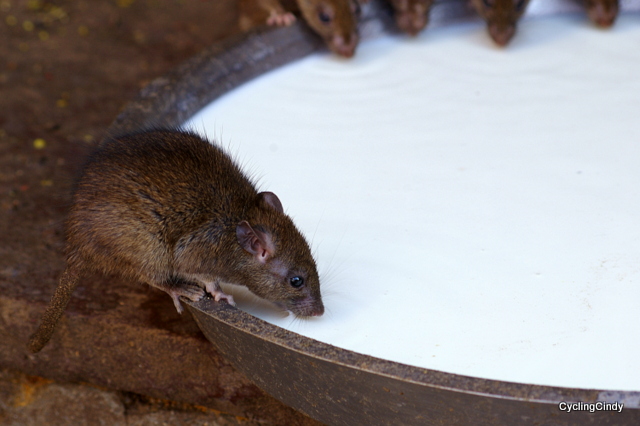
The rat temple in Bikaner
Holiness is still common in India. In most Hindu households, shops and businesses are altars and shrines, and the day is routinely started with the worship of gods and gurus. Many mountains, rivers, stones and trees are sacred. Dozens of cities are holy and the millions of temples and idols. Quite a few animals are holy: the cow, of course, but also the bull, the monkey, the elephant, the peacock, the snake, the rat. So it may come as no surprise that people can be holy too, though they have to become holy. The Indian concept of holiness is quite different from that in the West. It is not necessarily (though often) associated with the ‘good’. Have patience when shop owners need to perform rituals before doing the first business of the day with you.
H for Hospitality
In general, people tend to be less welcoming towards the foreigner. And that is very understandable, as there are loads of tourists. But even in the places where tourists are a rarity, people are just not that much into hosting and caring and fusing about you. I found it remarkable that people were very much interested in me, except when I was repairing a puncture along the road in the summer heat. The culture seems not to bother that much with strangers and foreigners and ‘guests’ but more with each on their own. Yet it is the most tiresome country to be in regarding attention.
Indians abroad are worth a different chapter and Indians with whom I worked on a voluntary base are extremely welcoming and caring. The sometimes very poor people I came in contact with were utmost hospitable too.
I for Intestinal Fortitude (or patience)

Times are gone that you had to wait many hours to obtain a train ticket, and not only because you are traveling on a bicycle. Times are gone too for an illogical number of handling’s to post a parcel (in case you need to send stuff home). There are still many handling’s but it has become slightly more logic. Still, patients is a good characteristic to honor in India. Logic is different here and patience a very healthy approach to many things in (Indian) life. Patience before you can check into a hotel room. Patience before you can start to talk about coming to the point. Patience about quietness. My most difficult practice in patience was not to get irritated. That became often the highest practice of patience throughout the day. Not to get irritated by the noise, by the starring, by the refusals of hotel owners, by the slow help offered by police, by not being alone. Patience became my biggest friend in India, from the first day I got there, 16 years ago. And up to today, I notice I benefit from it.
J… for … Jism
A Bollywood movie, erotic thriller even, with John Abraham and Bipasha Basu, two very attractive people. I couldn’t come up with a word starting with J, then this movie came to mind. I love Bollywood movies and it is a good way to escape daily life, as the locals do who flock to the cinema’s. An experience on its own! Bollywood movies aren’t that suggestive as they were 15 years ago, but the acting is still outstanding. Watching a Bollywood movie doesn’t need English subtitles. Even without translation it brings you closer to understand Indian lifestyle and it’s many facets of interactions.

K for Kilometer
This is very personal again but I noticed that I better bite the bullet because I found cycling in this country everything but relaxing. When temperatures rise above 50 degrees (122 Fahrenheit) it is important to pace yourself. I needed to stop regular and rest, drink and eat or I would get dizzy and fall of my feet. The other reason to pace myself came forth out of the irritation of being on the flats of the Indian continent. I found it not pleasant to cycle in the lowlands of India. It is noisy and crowded and if it is not crowded there is not a whole lot to be seen. It hardly ever became truly beautiful in surroundings (lots of agriculture). I needed to reset my perspective and get the striking views from different angles, that works well in India as this country is filled with small moments of heightened beauty. So, I would cycle for a full week each day and take a full week rest. I took a strictly 50/50 approach and that worked for me. The reward of cycling lay in reaching certain goals along the route, and enjoy them profusely.
K for Kurta
The ideal garment; a shorter one is perfect for cycling. It’s often made from cotton in whatever shape you like it; tight or wide. It is fashionable in every way and comfortable, although a tight kurta preferable needs a scarf draped in front of your breasts, so for cycling it’s not a good option. It has two splits on the sides and can be as short as you prefer, but usually covers the bottom. Having many kurta’s, one of my favorite is a farmer-style kurta from Rajasthan, intended for a man (I used this for cycling). The more progressive the young women, the shorter the kurta, if they don’t choose to go Western style. Yet, a very short kurta usually goes with a baggy kameez and not with a legging. Leggings are fine, but with a longer kurta.
L for Logic
Indians seem to have their own formed laws of logic. Which makes perfect sense, because how do you know something will be all right if it hasn’t reached that stage yet? So if someone answers you in a mystic way don’t try to have the person say what you like to hear. Is your way the only way? No, of course not. Is their way the best way? Maybe so. The fastest way is not always from A to B to C, logic is not always logic. In India it hardly ever is, which turns out often the most logic way. You get me?
L for Lodging
Seen through the eyes of not such old-fashioned ways; women do not stay on their own, not in a lodge either
There are all kinds of accommodation, in all price ranges and in all sort of comforts. However, the cheapest option, the most Spartan ones are not always in reach for a lone woman. I was simply refused and pointed towards a more suiting hotel by the owner, as a single woman would not be suitable in his lodging (stall-like boxes for young men only). Occasionally there was no other option, and thus I was allowed; I made sure I barricaded the door. Why? Continuous knocks on my door and excuses to have me open the door are a clear sign men want to get in a little too often for silly reasons. Just be on your wits and make clear you don’t like it.
In such situations it might be a help to have yourself made visible in the neighborhood. Go out to restaurants right opposite your lodging, let people know you are staying in that scruffy lodge so that social control starts. You might want to cover the window frame with a scarf, to avoid men peeping in your room and cover the keyhole with your underwear.
If you have a chance, stay in a non-touristy ashram, or temple lodging. It is cheap, clean, sparse and quieter. Mind you that staying in a Sikh ashram/temple lodging requires no shaving nor cutting your hair.
M for Manners
What are manners? That you don’t scratch the area of your penis when you have an itch there? That you don’t get the bulky hardness out of your nose when something’s stuck? That tough mucus needs to be coughed up, without covering your mouth? That the morning stands for gurgle and spit, preferable in a melody? That when you like to observe something, you watch it? Even though that is you eating breakfast. It is perfectly okay to ask the hotel boy run errands for you (give him a small donation). You may put trays and dirty plates in the hallway after you dined in the room. Manners are a way of adjusting and it gives you certain privileges too. As a woman you are allowed to jump the train ticket booth queue, and if someone objects you say ‘I am allowed, I am a woman’. No one will watch you when you spit and it is perfectly normal to grab money out of your bra. You may scream, you must scream when someone is in front of your bicycle! Usually, showing anger is not done but as a woman you may become agitated and make demands. Stand your ground and acquire what you want, but be respectful. This takes natural adjustments which grows over many years of being in India, but it definitely makes sense to use this side of your femininity. And remember, when people watch you in utter disrespect of manners, so can you! And the best thing of all, no one cares.
Manners of Indian people are quite opposite from European people, but that doesn’t mean it is wrong or bad or shameful. It is just different. Deal with it (yes, Cindy, goddamn, deal with it!).
Indian men generally don’t really have any affinity with gentleman manners, or, differently put: handle your luggage, unless it’s for a fee. Your bicycle, your panniers, your whole entourage: that is your problem. They rather like to watch you and smile -encouraging or mockingly- than getting up from their comfortable pillowed seat with a street view and give a hand. I prefer their hands helping me, but I fully understand that they don’t.
M for Man
The more I come to India the less troubles I have with men. The first few trips to India involved fighting men off. Literally. Men can easily get a wrong impression by Western women’s behavior, smiling, way of dressing and frivolous moves. Television and even Bollywood movies are probably part of this myth; that we are easy. Indian man are sexually quite frustrated, and often can’t believe their eyes when they see a western woman behaving so freely, that is; traveling on her own. Be clear and firm, dress appropriate and don’t shake hands if that’s not necessary (often it isn’t). In fact, any bodily contact is needless. Eye contact is a huge turn on, so keep that to a minimum.
I think as a woman on the bicycle you already make a rather clear statement: I can handle myself, thank you. Perhaps men become daunted by a woman like you, alone and het bicycle. Such a species must be strong. Yet, you are the weaker species to some of the men, they still want to help you. I learned it is easier to accept (when I am in the right mood) and let them arrange, for example, my hotel room. And then thank them with ‘goodbye, I have no phone, sorry.’
In general Indian men are not as disturbing as Iranian men can be, but they never reach the comfortable attitude African men have. Maybe social control has a lot to do with it. If you feel harassed, make it very clear you are not charmed. By being loud and obvious many people will notice and have the guy stoned with shame. Call the hotel owner when someone spies on you. Go to the police, throw a stone or fight.
N for Noise
This will be funny at first; bells, horns, motors, rattling of iron and metal, scrapping, honking, yelling, screaming, music, temple singing, calls to prayer, announcements, laughs, screams, water tickling, airplanes, sharp rickshaw sounds, low deep truck humming, mooing… But then you start to long for quietness and this will just never happen. Not until you are in the Himalaya. I used ear plugs to block out the worst noise. I suspect it is a matter of the mind…
O for Observation
What I mean with this is the look in your eyes, your confidence. This will help you tremendously in dealing with some people, more specific, men. India is a country where people want to help you; although this often seems the complete opposite (you might start to wonder whether they like to leave you to your own misery and unknown, it is not). The look in your eyes speaks a million words and it cannot be obtained by anything but only gained by experience of traveling. Then that look says it all: ‘Do not mess with me!’ On the other hand, people are helpful when you not expect it and this makes you tremendously happy. Ask people if you need help, as in India they might not recognize your seeking as such.
Some men, those sexually frustrated, need to be ignored, over looked as if they are not there. Try to see through them and do not smile friendly. Our Western ways are wrong for Indian men. We try to be friendly and correct while this might translate different to some frustrated Indian men. Some of them rather have negative attention which feeds them too, so I would advise to fully overlook them. In case of an already confrontation, be nasty, angry and very dominant. Now it’s an act of the toughest! YOU!
P for Poverty

This woman was part of a local NGO program representing the interests of elderly, left alone by her offspring
Oh gosh, this is a huge subject because poverty in India is overwhelming. It is right in your face and it can be difficult to handle. Children with flowing wounds, babies out on the pavement in the hot sun; a source of begging. Sick, blind and suffering; lined along temples and mosques. Rampant, overgrown sickness, diseases and tumors. Aids, cancer, leper, tuberculosis, hunger, third degree burnt, bloody amputees, discontinued operations…
I am not going into this matter too deep but will give you my guidelines on how I handle this. When children come begging I never hand over money (children should not be encouraged with earning money through begging while they can be in school too. Children might be runaways and handing over money keeps them on the street). Instead I am playful with those children, and notice they like playful attention so much that they quickly forget to ask money. Young mothers, with or without, either or not their own, children. Able young men and obvious addicts (glue sniffing) I refuse to hand as little as they may ask. I do hand over coins or small notes to elderly people (who often have no back up nor children taking care for them), very visible disabled (whose only income is begging) and one parent-homeless; mentally disabled usually don’t beg but are either ignored or tolerated by others. People obviously suffering and genuine sadhu’s tend not to ask anything and it is up to you.
Sometimes I am not sure whether my small donation would be offending? Often the locals show what is ‘normal’ to do. I hand over a little when I feel touched, by people making music or being inventive or performing a beautiful little show. I believe handing over money should help them towards a hopeful day, not a more greedy one. And I believe too that people truly in need usually do not ask, except when they have made their profession out of it without a leader above them. You will find out your own ways and on the road you hardly have to deal with any of this.
It is my strong believe not to hand out things. Medicines is a complete no go. Milk powder is bogus. If you want to do something worthwhile and something sustainable: find a way which will last longest and has least negative influence in the long run.
But on the other hand, India is so complicated that not one rule applies. I sometimes explain why I do not give money: ‘If I would give each who’d asked me a coin, I would soon be without’. Let your heart speak.
P for Parking your Bicycle

1) try to get bicycle in garage 2) upgrade it to hall 3) being in the hall, why not the room?
Some lodge owners refuse to have a bicycle inside the room, which is understandable. After all, a bicycle is a poor man vehicle. With some pressure I always managed to get my bicycle stored either in the room or somewhere safely inside. That’s the benefit of being a woman; you are allowed to whine and nag. Even though that is not what you are doing, it might be seen through their eyes as such.
Q for Questions

‘What do you like most about India?’
Being a bit tired of many little interviews a day, I answer the simple truth:
‘Mango’s!’
Inherently you will receive questions about your marital status, number of children, age, the price of your bicycle, income, caste and why you cycle. I have become similar to the Indians; I would like to know these details too, and often find myself asking them to strangers. When people ask you those questions, don’t be offended. India has so many boxes that some people want to see in which one you fit. If you believe that you don’t see the world in boxes, booths and hutches it makes it easier for yourself to just answer the questions. In turn you may ask whatever you wish for.
R for Refusals
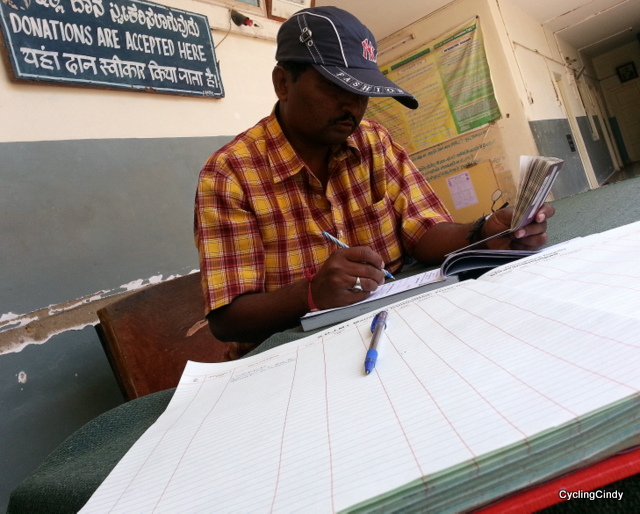
I can’t count the numbers of refusals I faced when seeking a place to stay. I talk about hotels, lodges and guest houses. Often I was ignored, send away, denied and lied to. I have found out the reason is that their register (a large book with your name, passport number and father’s name, and about 16 other importance’s) needs to be hand over to the police for control and when a weird name is among the list, they can be in trouble. It could be that the police needs those registers to solve murder-, prostitution-, theft- and terrorist cases. After a few refusals I learned not to become angry, but went straight to the police, sometimes with kind directions of the hotel owner. The police would always help me and put me up somewhere else. At all times this turned out positive for me, either I had free air-conditioning or the knowledge I was safe with the police as back up. The latter is a handy knowledge when staying the night in a place where used condoms lay around.
S for Staring

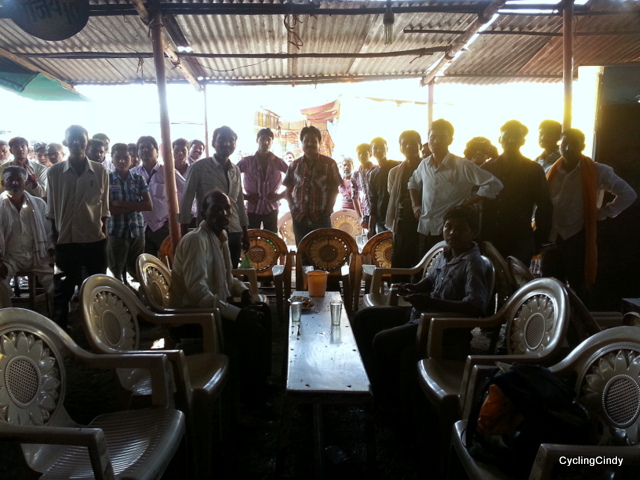
People stare. I don’t know why? Well, I do know why but I don’t get it why so extensive. The only reason I have come up with after all those years is that they are less educated (so, not uneducated and not well-educated but less). The lowest caste and ‘untouchables’ won’t watch you in disbelief. Of course, people who stare are amazed, curious, interested and are just simply fascinated by what they see. It is not an offending staring nor a wrong one. It is just annoying because they hold this gaze for many minutes, if not hours. At times, when I traveled by train (especially third class) I felt more comfortable by wearing full hijab, no split to see through, no one to see even as much as my eyes. When in motion on the bicycle is it not an issue but once you stop to eat, it is you who is performing the one-man-show, your audience will be growing by the minute. It’s best to accept it and assume it is as normal as breathing. Because people will post themselves right opposite you in an otherwise empty place. Cooks will come out to see you eat their prepared meal. When you stop a hedge of humans grows around you. Eyes are fixed on every move you make, even if you act annoyed, the message will not arrive, because they are simple watching the one-man-show.
S for Solitude


All alone, for days, up on high hill, in an old crumbling fort. I treasured the silence and alone time…
It is possible to seek and find alone-time outside the Himalaya too. Jammu & Kashmir, Punjab and Gujarat are more comfortable. Gujarat is a state where people seem to leave you more alone. But if this state in the North East is not on your itinerary seek for little touristy gems. Such very touristy towns in the summer heat are very relaxing, as locals are used to foreigners but the foreigners not to these simmering heat. It could be very well possible to have a complete fort and palace to yourself, you only need to share it with monkeys. An ashram or meditation course could be an idea too.
S for Sickness
It is very possible that you get sick. The good thing about getting sick is that there is always a doctor willing to help you (even a private hospital is relatively cheap according our standard). He might write you a long list with possible medicines for treatment, check whether they are all necessary. Another good cause of getting sick is that treatment is cheap and best of all you get the chance to recover with Ayurvedic products. Ayurvedic is a holistic approach about being and staying in balance. Naturally you should stay balanced so you won’t get sick, in that case it is still a very nice introduction to Ayurvedic products. The first you will come along are Dabur, Patanjali and Himalaya. Wait with buying new soap and toothpaste until you are in India!
T for Traffic

Traffic in India is insane, we all know that much. It’s way worse than big cities in China and Nigeria, or cities such as Cairo and Rawalpindi (Pakistan). But believe me when I say that it looks worse than it is. Once you are a participant of the road, people move around and away from you. Although you are the second least important participant, cars and trucks will avoid driving over you. They will cut you off but you on your turn may ride into pedestrians if you need to, and no one will bother, the pedestrian neither. When you are cycling towards a ‘roundabout’ without a visible circle or just a heap of motorized tin-plates, remember not to look around you for oncoming traffic: just bang right through it. Unlike cities such as Dubai, car drivers are used to all sorts of transport on the road with which they have to share space. You on a bicycle is not exceptional at all.
I often gave sleeping dogs a notice when I would pass them, since they are sleeping soundless I didn’t want to scare them off and have them jump in an unpleasant surprise.
T for Touch
Opposite to some African and South American countries it is not done to be touched. So don’t let men be too familiar or touch you at all. Not if that’s for a photo, not even a shoulder. Back home they may rave about having a Western girlfriend, but let it be one who keeps a safe distance. Your bicycle however, will be touched to such an extend it made me want to protect it as if it were my child. They will try to lift it up, ring the bell, stroke the handlebars and saddle and would love to ride it.
T for Touristy
It is certainly not sure you will meet other tourists. The whole route from Cochin to Delhi I haven’t seen one tourist. Isn’t that absolutely wonderful?! I think it is. I have cycled through big towns such as Mysore, Indore and Bangalore without seeing an obvious touristy person. Even the city of Jaipur was void of any foreigners. Well, Jaipur is big and the tourists gather on a particular small place deep within the city. Those real touristy hang-out spots turned out to have a huge positive effect on me: that of not being an outsider. Abruptly I wasn’t stared at anymore, not a focal point of a whole group, not denied access to a hotel, not misunderstood, not laughed at, not seen as funny. Suddenly I was one of them and it felt heartwarming anonymous. The downside is that you are seen as one of the easy targets and respect might omit by the surrounding of half undressed women. The food tends to be concentrated on European taste buds and has lost Indian delicacy. And shop owners think they can cheat on you with ridiculous prices or bad quality.
U for united
Indians move in groups. They live in groups, they do things in groups. Being alone is sad. ‘Why you are alone?’ is a regular returning question. I would answer that I haven’t got friends who like cycling. Having no partner and no children is also a failing from your side. But there are plenty of people who think outside these boxes too. Be aware for (school) groups: they are loud, curious and inquisitive although well-behaved. I often fled from big groups like school children or huge families where the girls often go crazy or are so shy they can’t stop giggling. Many people live on small spaces with their (extended) family, queuing is learned to fit each other like dominoes, withdrawing money is not a private matter for others and peeing in the fields can be done with guys watcing you (if you don’t mind) (and I did mind).
V for Vehicle

The road stops to exist in Kibber, a wired bridge is the only way to get to the other side. About 4000 meter high, North India
I sometimes needed transport in the form of a bigger vehicle than mine. Photo above shows a form of transport connecting two canyon walls, but I needed to cover a little distance towards my cousin too (and since it was not in a vertical direction I allowed myself to do so). Note that not all buses of the State Transport Cooperation leaving at a big bus stations take bicycles with them. India is not as it used to be and aisles of buses are clean and free of rubble (including bicycles). Only Governmental and commercial buses with storage in the back or side take bicycles for a little fee.
W for Weather
It can be hot out there. Sleeping in lodges without an air conditioner or water cooler is waking up tired. In summer (May, June, July) temperatures reach above 50 degrees daytime while night-time they go as low as 38. Electricity often fails so the fan will act accordingly. Stingily I refused to get a room with air conditioning and tried to keep cool by hanging a wet cotton scarf in the wind flow, or drape it over me. Locals would go out before 9 o’clock and retire until 4 in the afternoon to go on about their tasks. Exactly my cycling hours…
To keep your electronic devices cool, drap a burlap sack under the straps of your panniers and keep them wet. The wind will keep it cool. That’s the benefit of cycling in hot weather; the self generating wind you won’t have when walking on a day off the bicycle. Placing a wet handkerchief under your helmet or cap helps too, as does a turban. To a certain extend: the more you cover up, the cooler you’ll be.
W for Water

Kulfi ice cream is traditionally prepared by evaporating sweetened and flavored milk via slow cooking
Water, ice cream, salads, peeled fruit, whether or not covered in flies: it’s not more dangerous than traffic. Water from the tap is mostly safe. My rule is: if they drink it, I can. If you know your system is not very adapted, don’t. I drank water from the streams in the Himalaya, and that might be how I attracted amoeba. Honestly, I am not going to do effort in trying to keep a bug, parasite, infection or diarrhea at bay. Although I haven’t attracted diarrhea previous 5 months cycling in India, usually India presents you with one or the other, even if you do take care, and especially if you take extra special care.
X for Xenofobic
Indians, of all people, are curious and will never ever ignore you (that is a lie, they will. They ignore you when they are not in the mood to sell, to rent or to be bothered). All beliefs, all cultures, all religions, all types, sorts and looks, all is in India. Indian people will ask you many sort of questions, which might look rude at first. But what’s wrong with asking? They have no fear of strangers at all. They might give you silly advise like ‘go to the hospital’ when someone finds out you don’t have children, but they are just fine with answers going completely against their ways. They tolerate even the weirdest traveler, which you will see in all kind of forms in overly touristy places. Though, a woman alone on her bicycle is quite weird…
Y for Yes or No or I don’t know or Maybe

Known as wobbling the head. This beautiful side way movement of the head can mean ‘yes’, ‘no’, ‘maybe’, and ‘yes, I don’t know’. An Indian tries not to utter the words ‘I don’t know’, he rather lie than admitting not to know. That’s one of the reasons to ask your question in such a way that it is impossible for the person to answer with ‘yes’ or ‘no’. Preferable, ask three people the same question and usually the answers which coincides is correct. Ask educated women; good chance they will answer truthfully and honest. Asking directions by rickshaw drivers, taxi drivers and police men works well too; they have guided me through Bangalore towards my niece with not one single junction missing.
Z for Zingy
Pleasantly stimulating, exceptionally attractive or appealing, vibrant, energetic, lively. That is India! Except when you seek solitude in the Himalaya, you are out of the circus. Otherwise; it is a mayhem every moment. India is zingy in it smells and as soon as you cross the border, even by land it’s the smell of India collecting in your nostrils, never to leave again. It’s more than piss only, its burnt wood, chili, sandy dust, frangipani flowers, cinnamon, jasmine, cardamom, incense, and dry grass. Zingy are the colors of the clothing, the cute hand-knitted V-neck sleeveless pullover of the men in cold areas (25 degrees) and the adornments on women’s feet. The colors of food, the street life, the pigs feasting in the gutter, the dogs having group naps, the children having a scream contest, the advertisements along the road, the shops, the Gods. All is zingy in India.
Read this post of India to get an idea how it can be
This post is how to obtain the Indian visa in Oman (very changeable)
This post is only about avoiding difficult situations with men









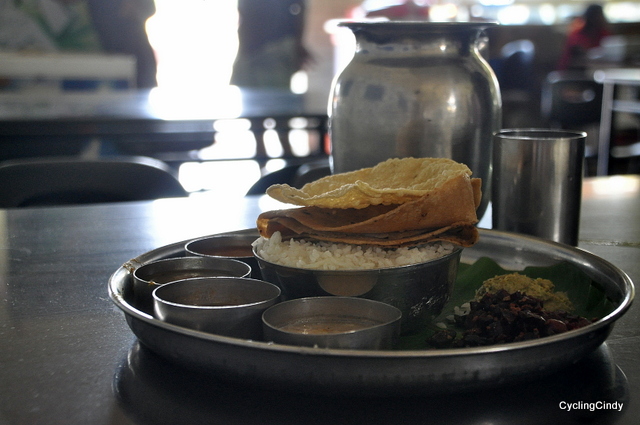





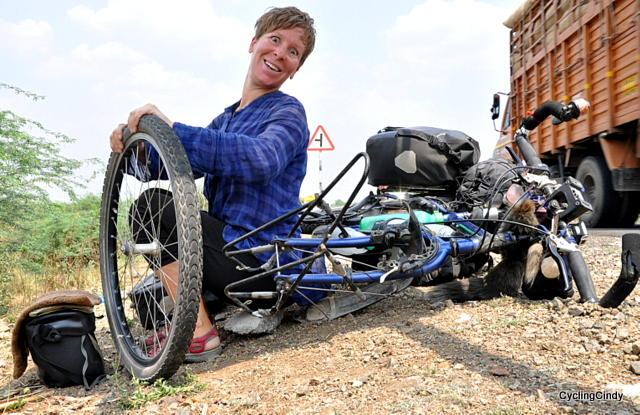














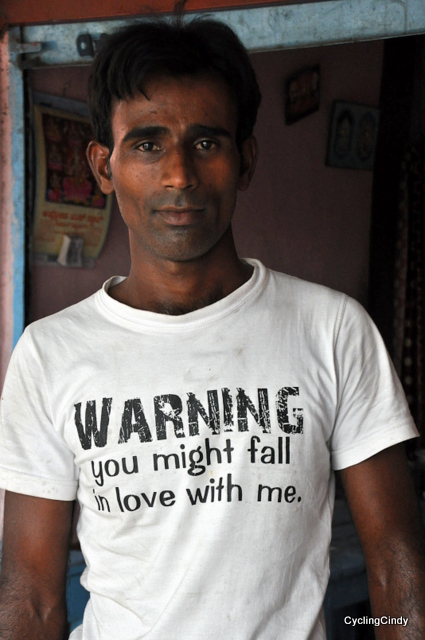
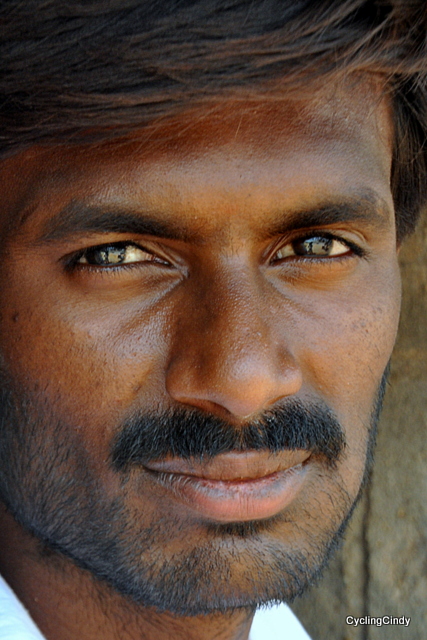







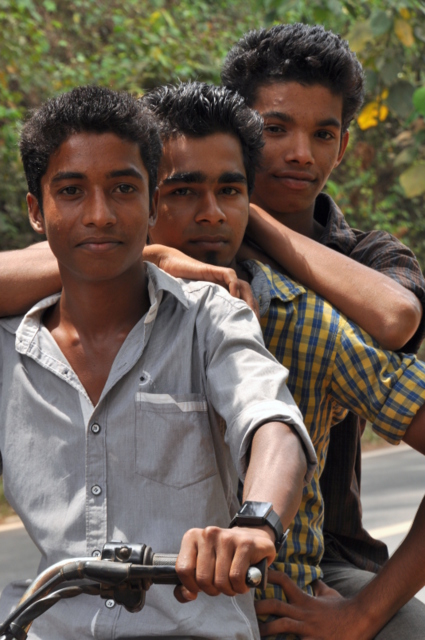





5 replies on “India from A to Z”
So right! I ejoyed reading this tremendously!
LikeLike
I thought you would, Rita! Although you have been once, no, twice, in India… I know how much you have experienced the full experience!
LikeLike
[…] A to Z for India […]
LikeLike
[…] India A to Z My findings about India […]
LikeLike
[…] cycling through India I wrote a lenghty A to Z post. It contains everything I think is important or nice to know about India, starting with the […]
LikeLike